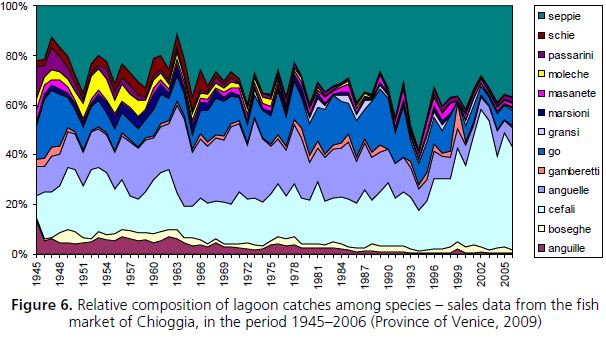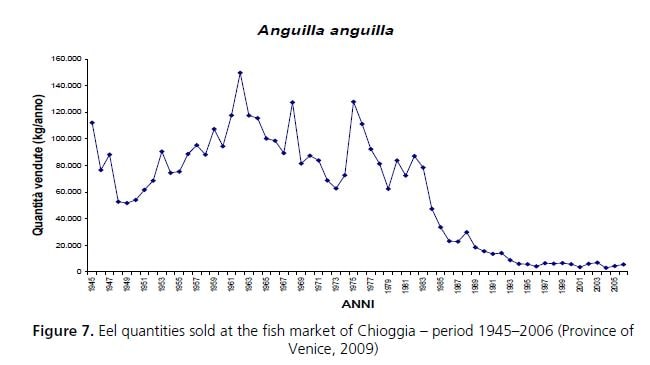6.3 Living resources
It is extremely difficult to describe living resources for all the Italian coastal lagoons. A comprehensive overview is given in Ardizzone et al. (1988), which summarizes all available information concerning planktonic as well as benthic communities and fish. In recent years, the quantity of information available concerning living resources in Italian coastal lagoons has greatly increased because of the implementing of monitoring in many coastal ecosystems. Monitoring
campaigns are due to the need to document environmental quality, to follow interventions, to address requirements under the Water Framework Directive, etc.
The level of scientific knowledge and of information being updated on water quality and living resources is not the same among the numerous lagoons in Italy. Some ecosystems have been extensively studied in definite moments, monitoring most components of the ecosystem. Such is the case, for example, of the lagoon of Orbetello, where a number of studies have been put in place across the end of the 1990s and 2000 because of the need to document the environmental situation and to follow the outcomes of the interventions made in the lagoon (Innamorati and Melillo, 2004).

Figure 4. Location of the 53 Ramsar sites in Italy (Source: Ministero dell’Ambiente)
In other lagoons, where the main involvement is conservation of wildlife and biodiversity, as in the case of lagoons within National or Regional Parks, surveys were mainly aimed at 133 documenting changes in biodiversity. This is the case of the Pontinian coastal lakes in central Italy, where the lakes living resources were characterized extensively in the 1980s, in the 1990s and again in 2006.
The lagoon of Venice is the lagoon where the most intense monitoring programmes are taking place. In 2000, based on the experience and knowledge gained in the previous 15 years, an integrated monitoring system (MELA, Lagoon Ecosystem Monitoring) was started by the Consorzio Venezia Nuova, concessionaire of the Magistrato alle Acque di Venezia, to provide information related to protection, control, surveillance and monitoring of the lagoon system. This system has then evolved over the years in a system of interlinked activities, often integrated with other institutional monitoring systems and with specific studies developed by Public Agencies and Public Institutions. The system represents an opportunity for comparison, sharing and diffusion of knowledge among administrators, practitioners, researchers and experts working on this complex lagoon ecosystem.
Given the importance of fisheries in all coastal lagoons in Italy, even for those lagoons where scarce or no information is available on living resources, fisheries data can somehow document, at least partially, the fish community. Fishing data are not always available in a published or documented form; nevertheless, for most lagoons some information can be obtained, if nothing else at least from a quantitative point of view.
Coastal lagoons are important sites for fish, as growing areas, wintering sites, migration routes and more generally areas that naturally support a large density of individuals (Franco et al., 2006). The basic structure of fish communities of Italian lagoons is not very different from that of other Mediterranean lagoon environments, and shows a substantial stability. This is because, despite the fluctuations of abiotic and biotic parameters, factors that determine this structure can be attributed in all cases to the dominance of tolerant taxa and to the structure of food webs that are established in these systems.
The state of lagoon fish productions can be an important indicator of the ecological status of the ecosystems, and in particular historical catches may provide important clues about the status of a lagoon ecosystem. The limitations lie in the fact that fluctuations in the catches, and species composition of catches, can result from several environmental as well as socio-economic factors. Indicators of fishing effort or catch per unit effort should then be needed, to correctly interpret the observations. Despite these limitations, in many cases this approach has proved informative. An interesting example are the lagoon of Venice fisheries, illustrated by Libralato et al. (1994), and then again presented and updated in the “Plan for the management of the fishery resources of the lagoons of Venice and Caorle” (Province of Venice, 2009).
Time series of catches as recorded at the fish market of Chioggia for the period 1945-2006 have been used, by retaining only the catch of the artisanal fishing in the lagoon, relative to these species: plaice (Platichtys flesus), eel (Anguilla anguilla), mullets (Chelon labrosus, Mugil cephalus, Liza ramada, L. saliens and L. aurata), sand smelt (Atherina boyeri), the gobid go (Zosterisessor ophiocephalus) and marsioni (Pomatoschistus spp.), crabs (moleche and masanete, Carcinus mediterraneus), shrimps (Palaemon spp.), grey shrimp (Crangon crangon), cuttlefish (Sepia officinalis).
Except for 1945, still affected by the war, the initial period of the time series considered (1946-1957) shows a stable production between 1 000 and 1 500 tonnes per year. From 1958 to about 1975, lagoon catches show an increase in the quantities sold each year, to about 3 500 tonnes per year. The next period 1976–1984 is instead characterized by marked fluctuations in landings per year, from just over 2 000 to less than 3 500 tonnes per year. Finally, from 1985 to 2005 there was a decreasing trend in the quantities sold at Chioggia to values even lower than those observed at the beginning of the series (Fig. 5).

Figure 5. Fish yields in the Venice Lagoon – sale data from the fish market of Chioggia, in the period 1945–2006 (Province of Venice, 2009)
This time pattern can be explained by changes that have affected the fishing fleets of the lagoon over time. The introduction and spread of motor boats in the fleet since the 1950s, that certainly improved the efficiency of the fishery, would be primarily responsible for the increase of catches observed in the first half of the period of time considered. The competition between the small-scale fisheries in the lagoon and the emerging activities of mechanical harvesting of the Manila clam, introduced in the lagoon in the mid-1980s, would then explain the collapse of “traditional” fisheries production observed in the 1990s (Granzotto et al., 2001).
The significant decrease of production in the lagoon, recorded from the mid-1980s, actually precedes the outburst of clam production, which becomes significant only in the late 1980s (Turolla et al., 2008). Thus, the reverse is true, i.e. that the introduction of the Manila clam in the lagoon can be read as a response to the crisis in the traditional fishing industry. The competition between the two fisheries, artisanal fisheries and harvesting of clams, can then explain the further decline of traditional fisheries registered since the 1990s (Fig. 5), coinciding with the dramatic increase observed in production of Ruditapes philippinarum.
Significant differences in the time series of the lagoon catches can also be found in terms of relative composition of the species. In particular, since the late 1980s there has been a marked increase in in the catch of cuttlefish and mullets at the expense of all other species (Fig. 6). For some specific resources, the decline in annual production in the period 1945–2006 is particularly significant, as in the case of the shrimp, the green crab during molting (“moleca”), the go and the plaice.

Figure 6. Relative composition of lagoon catches among species – sales data from the fish market of Chioggia, in the period 1945–2006 (Province of Venice, 2009)
A most significant reduction was observed in the eel catch of the Venice lagoon (Fig. 7), and a similar pattern is described in all Italian coastal lagoons.

Figure 7. Eel quantities sold at the fish market of Chioggia – period 1945–2006 (Province of Venice, 2009)
In the Valli di Comacchio, the trend in the course of those two centuries has always been characterised by fluctuations ranging from 6 to > 30 kg/ha, attributable to such environmental problems as hypersalinity and freezing of the valli. The average annual yield of eel per hectare was 14.3 kg, about 78 percent of the total fish production. Higher yields were obtained after 1964, coinciding with restocking and seeding practices whereas, from the late 1970s, production has been considerably lower (5–7 kg/ha), attributed to falling recruitment in the Comacchio lagoons. From 1990, owing to environmental problems and to internal problems of the Consorzio Valli di Comacchio, eel production reached its historical minimum, falling to less than 5 kg/ha, stockings having been completely abandoned. Catches consist now only of large eel, the older individuals still inside the lagoon (Ciccotti, 2005).
The main limiting factor for eel production in lagoons today, apart from the habitat changes related to coastal waters eutrophication and pollution is the decline in recruitment due to the contraction of the eel global stock. National glass eel catches are used for lagoon restocking, and the fall in recruitment and the consequent decline of glass eel fisheries cannot be compensated for by imported seed, also because of rises in prices. This, together with the fact that the eel life cycle in lagoons is rather long (average seven years) and hence non-competitive with the aquaculture product, means that other species are preferred when local management strategies are formulated.
Figure 8 reports eel catches from all Italian coastal lagoons for 1969–2010, from the Italian Statistical system, that up to 2004 was responsible for the collection of fishery data for marine and coastal waters. Since eel is not present in marine waters in Italy, data can be considered relative only to Italian coastal lagoons. Catches show an evident decreasing trend, which took place during the 1980s, with yields decreasing from an average of 1 500 tonnes in the 1970s to about 500 tonnes in the 1990s to <300 tonnes in 2000. This declining trend is in accordance for the trend observed elsewhere in Europe for this species. The general picture on the status of eel stocks and fisheries throughout Europe displays in fact declining recruitment and reduced yields, apparent both for capture fisheries and for scientific indices. In relation to this situation, debate on the possible measures to protect the European eel stock is topical at the present moment, also in relation to a series of steps undertaken by the European Community, such as the issue of a specific Regulation (CE Regulation 1100/2007) outlining measures for the recovery of the eel stock (see Case Study 4, PART 3).

Figure 8. Eel yields from Italian coastal lagoons (Source: Istituto Nazionale di Statistica 1969– 2004, blue: Mipaaf, 2007–2010, red)